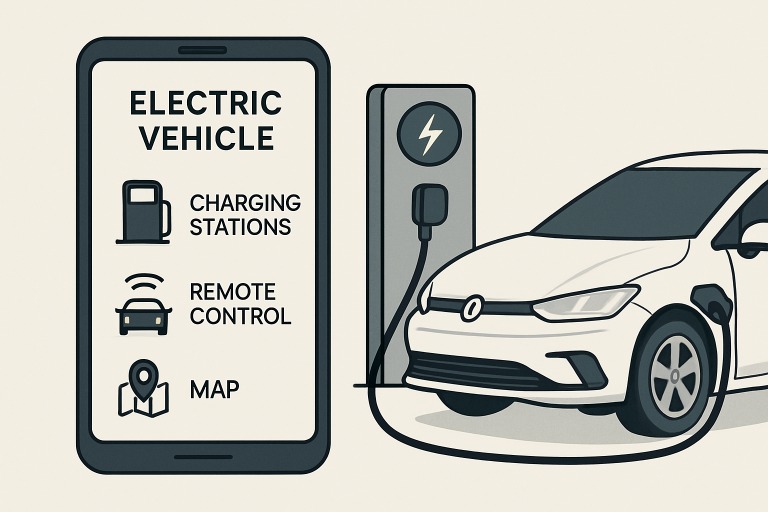Introduction
The electric vehicle (EV) shift goes beyond the cars themselves—software is becoming a critical factor in making sustainable mobility widely accessible. Mobile apps are now a core part of EV ownership, helping with everything from charging ease to trip planning. With these tools, drivers can quickly find charging stations, track charging in real time, and even manage vehicle functions remotely, greatly improving the overall EV experience. For instance, Blink’s app for EV charging enables drivers to locate available charging stations, track sessions, and manage payments directly from their smartphones.
Mobile apps are transforming EV ownership by improving convenience, reliability, and user experience. They help drivers plan routes, manage maintenance, and streamline everyday use, making EVs more appealing than traditional cars. A J.D. Power report shows strong adoption, with 90% of EV owners using their manufacturer’s app and 67% relying on it for at least half their trips. As demand grows, expectations for app quality and innovation are rising, positioning these digital tools as future industry standards that drive satisfaction and adoption.
Enhancing EV Ownership Through Mobile Apps
For many drivers, the decision to switch to an EV includes concerns around charging access, trip planning, and vehicle maintenance. Mobile apps address these issues by making real-world usage seamless, thereby reducing the friction points commonly associated with EV driving. As the industry evolves, apps enable practical solutions, such as immediate charging station availability, streamlined route planning with live traffic data, and on-the-go access to vehicle diagnostics. According to Kelley Blue Book, these charging apps not only help drivers locate compatible stations but also enhance the overall ownership experience by combining convenience with real-time functionality.
The everyday benefits are readily apparent. Direct-to-consumer services have become integral, whether through push notifications about tire pressure, reminders to charge, or the ability to remotely adjust climate controls before entering the vehicle. Additionally, the integration of digital payments simplifies energy purchases—no more fumbling through payment cards or navigating unfamiliar interfaces at public chargers. As municipalities and private businesses invest in public charging infrastructure, apps bridge the gap between growing networks and driver confidence, supporting a more sustainable transportation landscape.
Key Features of EV Apps
- Charging Station Locator: Real-time mapping of nearby compatible chargers, showing availability status and directions, alleviates range anxiety and increases trip flexibility. According to U.S. News, resources like EV charging station guides also help drivers better understand the different charger types and networks available.
- Remote Vehicle Management: Through app controls, users can monitor battery status, start or stop charging, adjust cabin climate, and receive proactive maintenance alerts—often from anywhere in the world.
- Route Planning: Innovative navigation tools incorporate live traffic conditions, estimated charging needs, and suggest optimal charging stops, allowing longer, uninterrupted journeys. Integration with mapping platforms further improves travel efficiency.
- Over-the-Air Updates: Many EV manufacturers leverage mobile apps to deliver software updates, enhancing vehicle performance, safety features, and digital experience without requiring workshop visits.
Challenges in EV App Development
Despite their many benefits, EV mobile apps are not without their setbacks. As app functionalities become more advanced, the demand for real-time, reliable performance grows. Connectivity issues are frequently attributed to both poor network coverage and software development gaps, especially as these apps must coordinate data across multiple hardware and infrastructure partners.
Security and privacy are also primary considerations, with users needing assurance that their vehicle and personal data are protected. Increasingly complex systems—like remote access, payments, and integration with home energy management—require robust cybersecurity measures. The challenge for developers is to provide seamless utility without exposing vulnerabilities that cyber threats could exploit.
The Future of EV Apps
As the electric vehicle industry matures, mobile apps will continue playing an essential and innovative role. Several trends are beginning to define the next generation of EV apps. Peer-to-peer charging platforms—where individuals can share private chargers—have emerged, potentially revolutionizing access and reducing reliance on public charging infrastructure. Gamification and rewards for eco-friendly driving habits and smart energy usage encourage sustainable behaviors and greater engagement.
Integration with smart home systems marks another exciting frontier. Imagine an app that not only synchronizes with your car but also manages your home’s solar panels, energy storage, and charging routines, delivering energy savings along with convenience. Connectivity between transport and home ecosystems could encourage holistic sustainability while simplifying daily routines for drivers.
Conclusion
Every day, mobile applications are fundamentally reshaping how drivers interact with their electric vehicles. By bridging critical gaps—such as charging access, trip planning, and ongoing vehicle management—these apps help mitigate common EV fears and unlock the true potential of electric mobility. As automotive and software industries continue to converge, ongoing innovation and reliability improvements will be key to supporting widespread EV adoption and a more sustainable future.
In addition to enhancing the driving experience, these apps are also streamlining maintenance and repair processes for electric vehicle owners. By integrating diagnostic tools and service scheduling features, users can easily identify issues and book repairs without hassle. For those needing immediate assistance or specialized electrical repairs, it’s now simpler than ever to get in touch with professional services that ensure your vehicle remains in top condition. This seamless integration of technology not only saves time but also enhances the overall ownership experience, making electric vehicles more accessible and convenient for everyone.





Leave a Reply